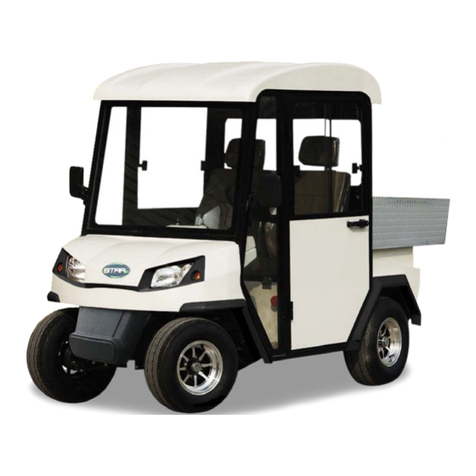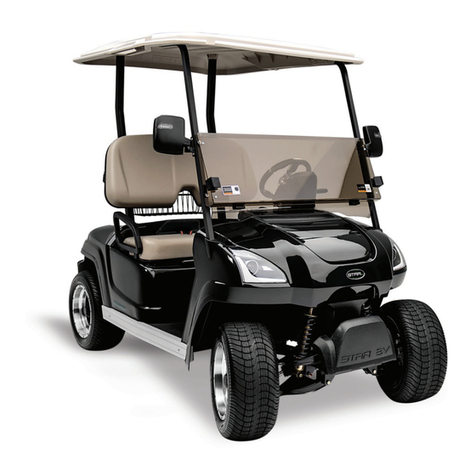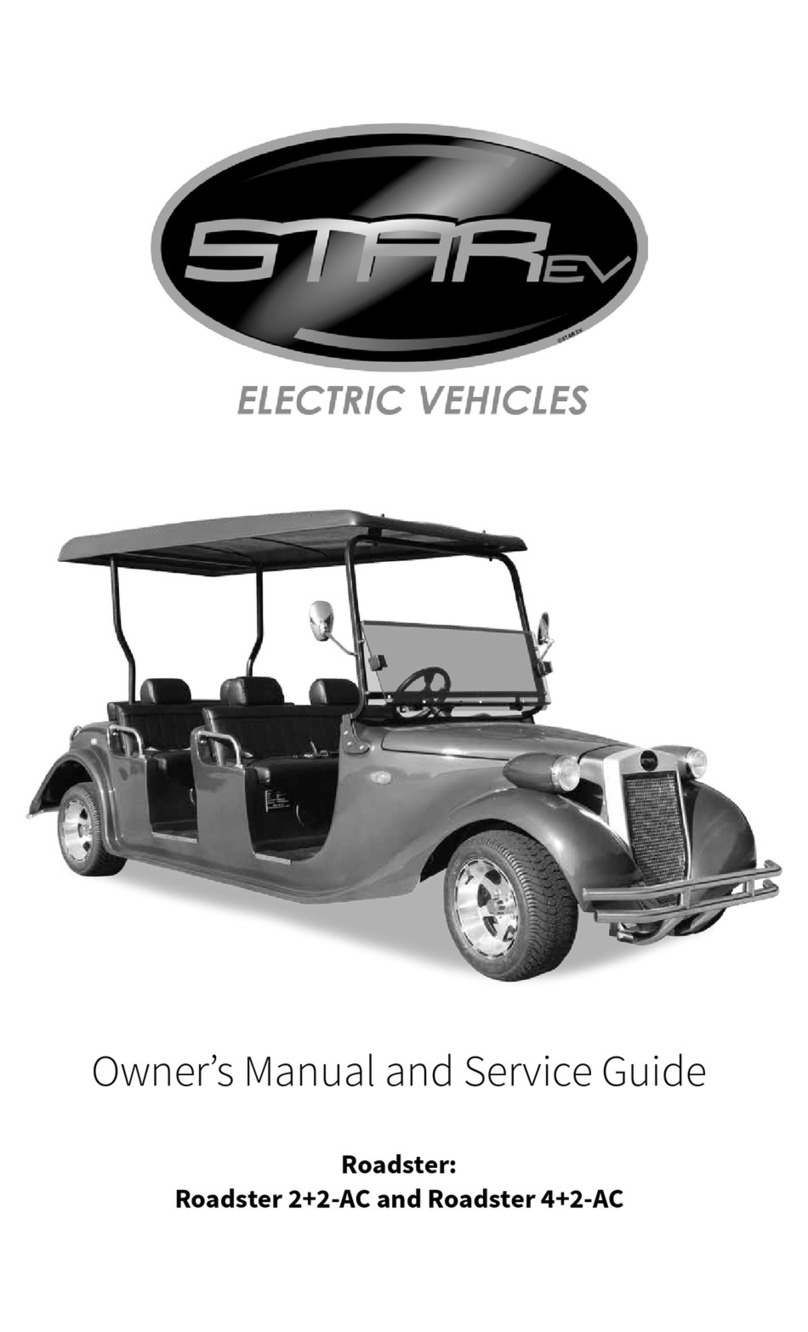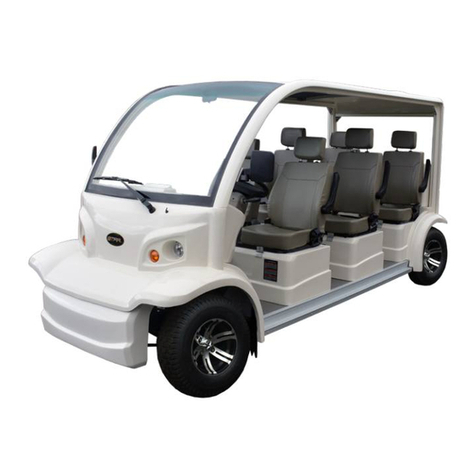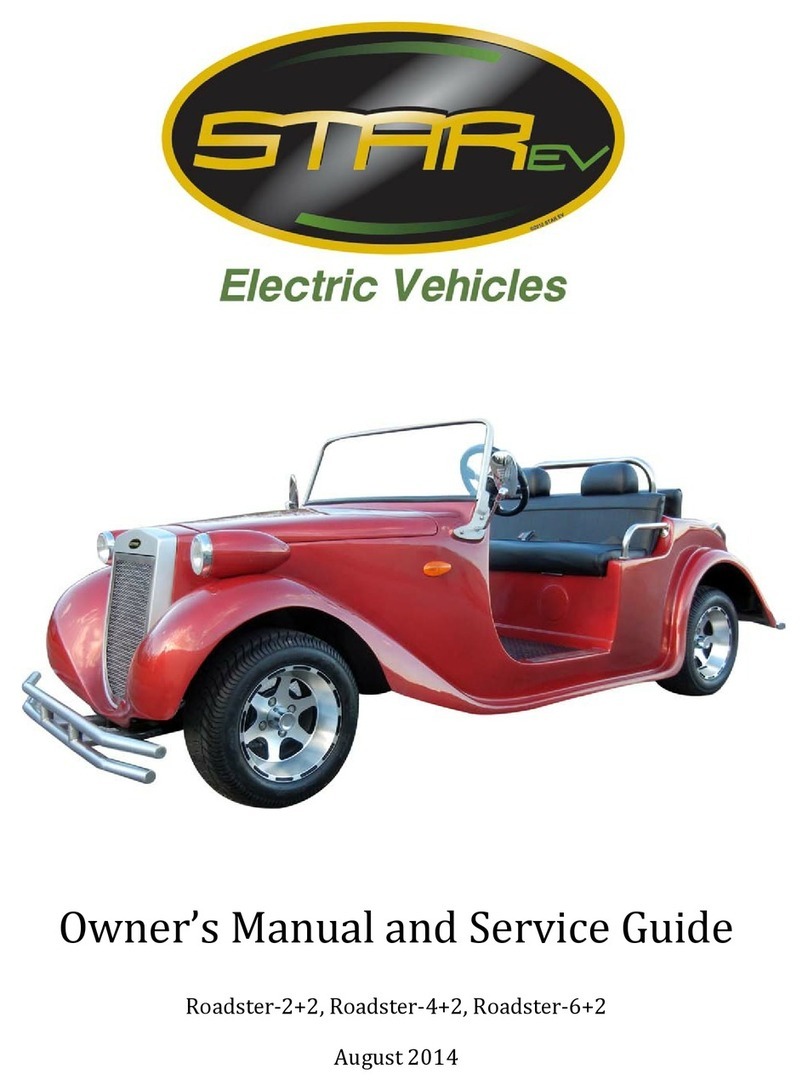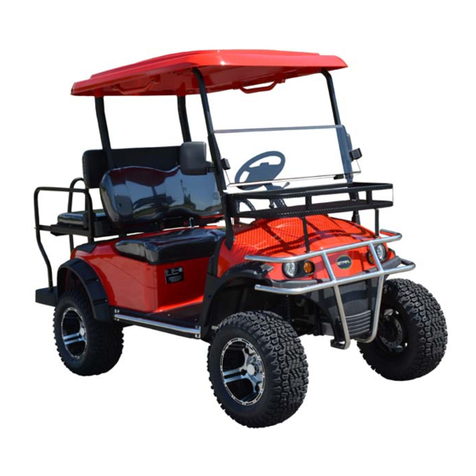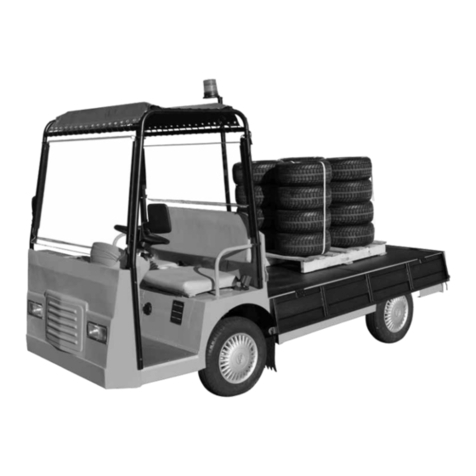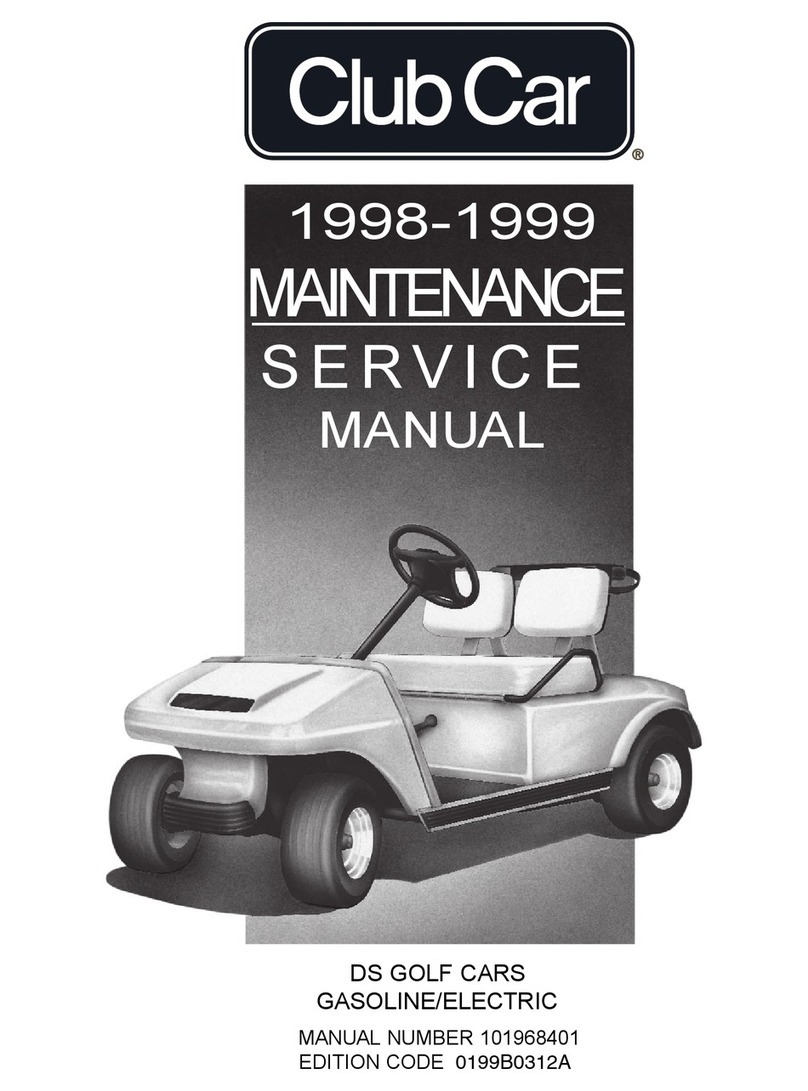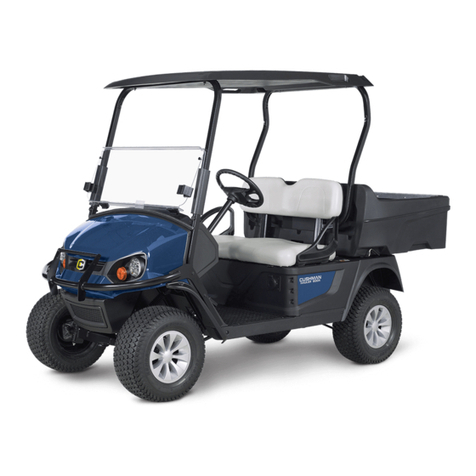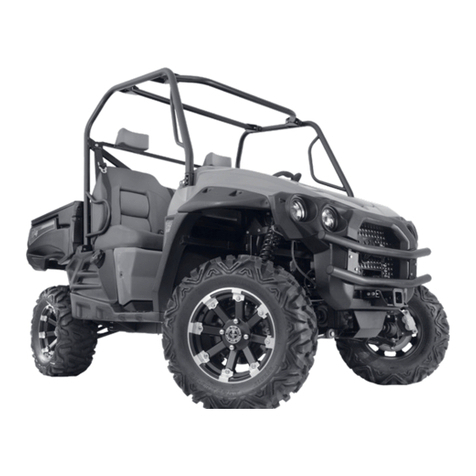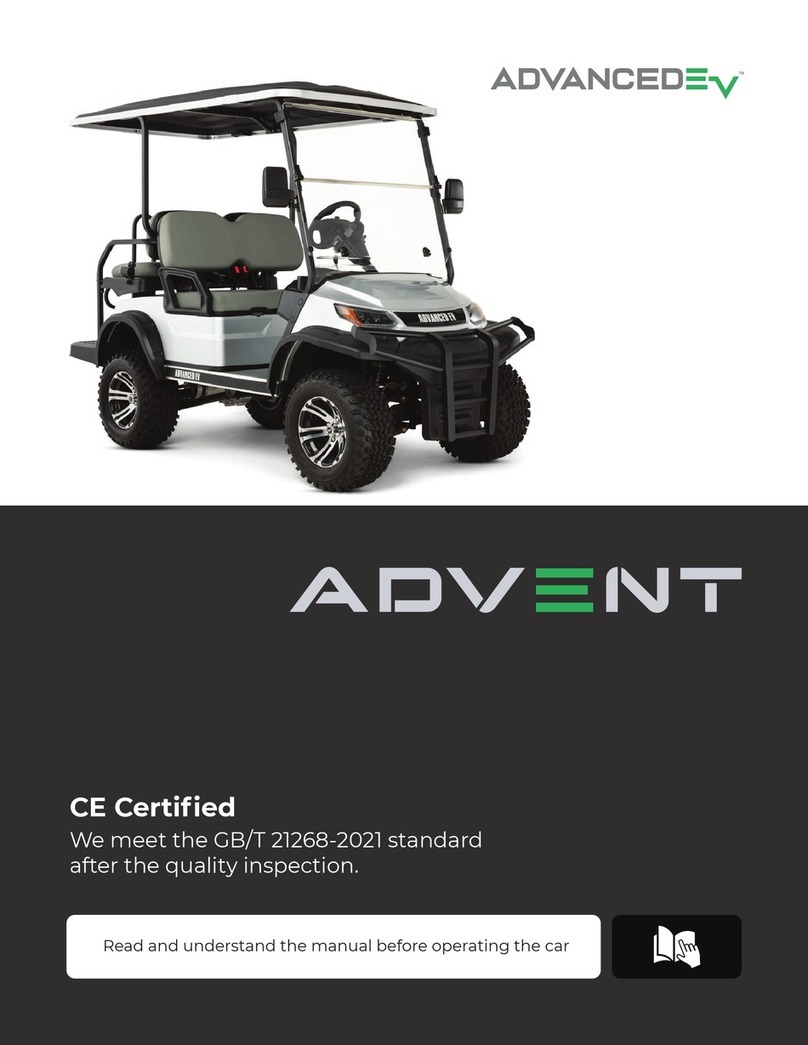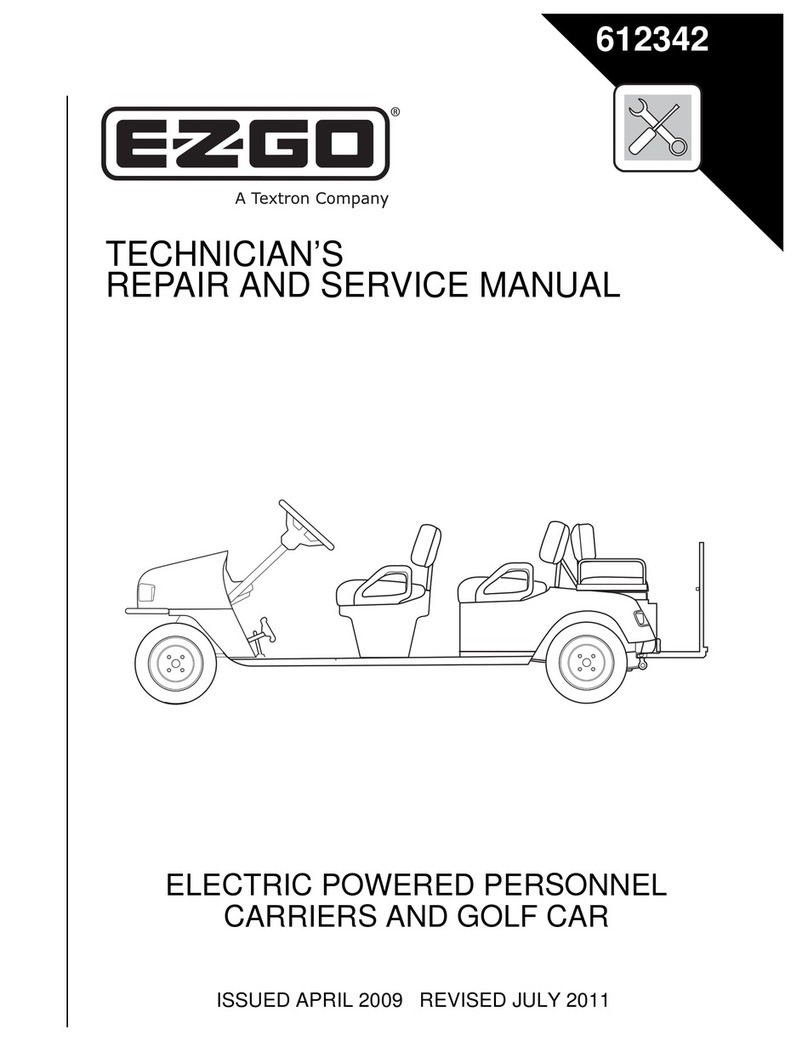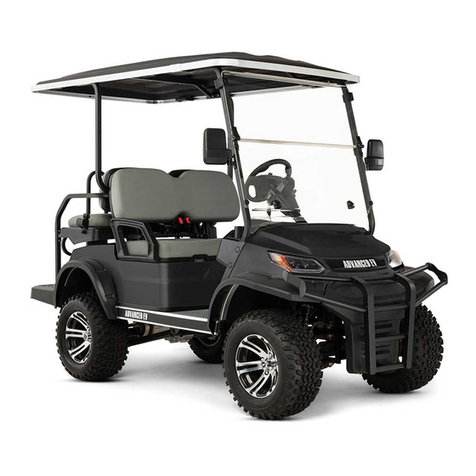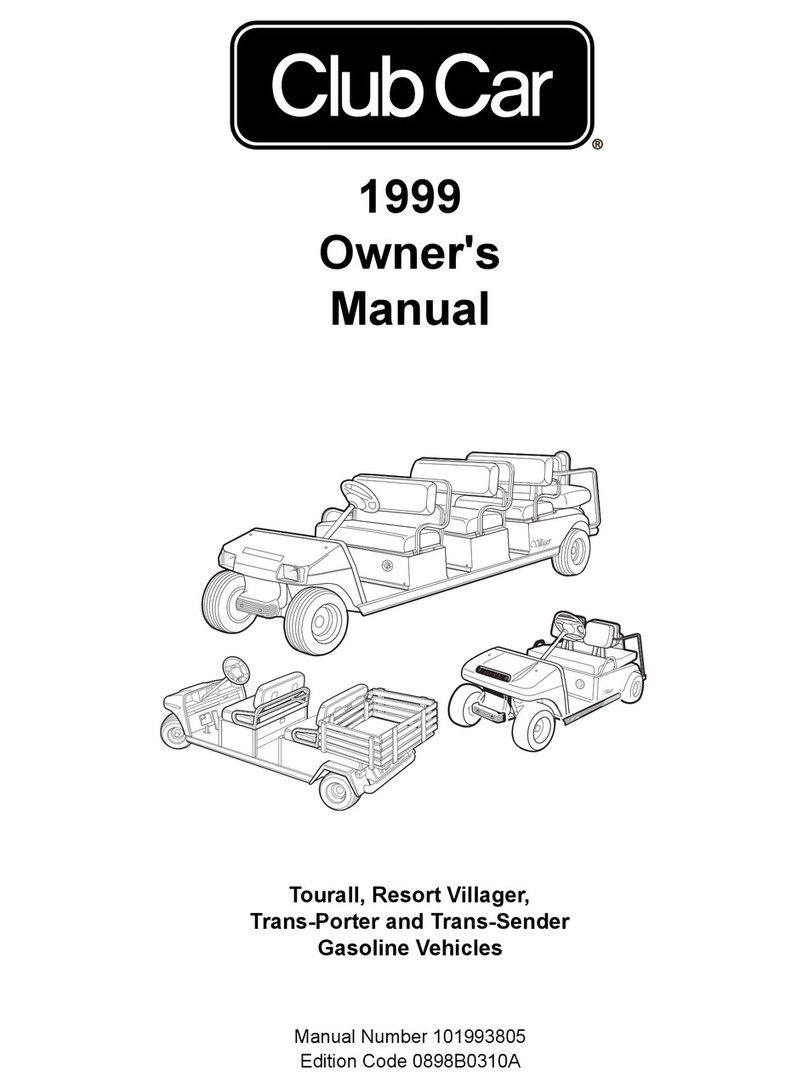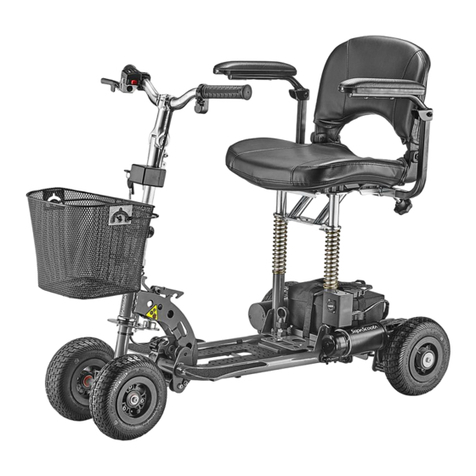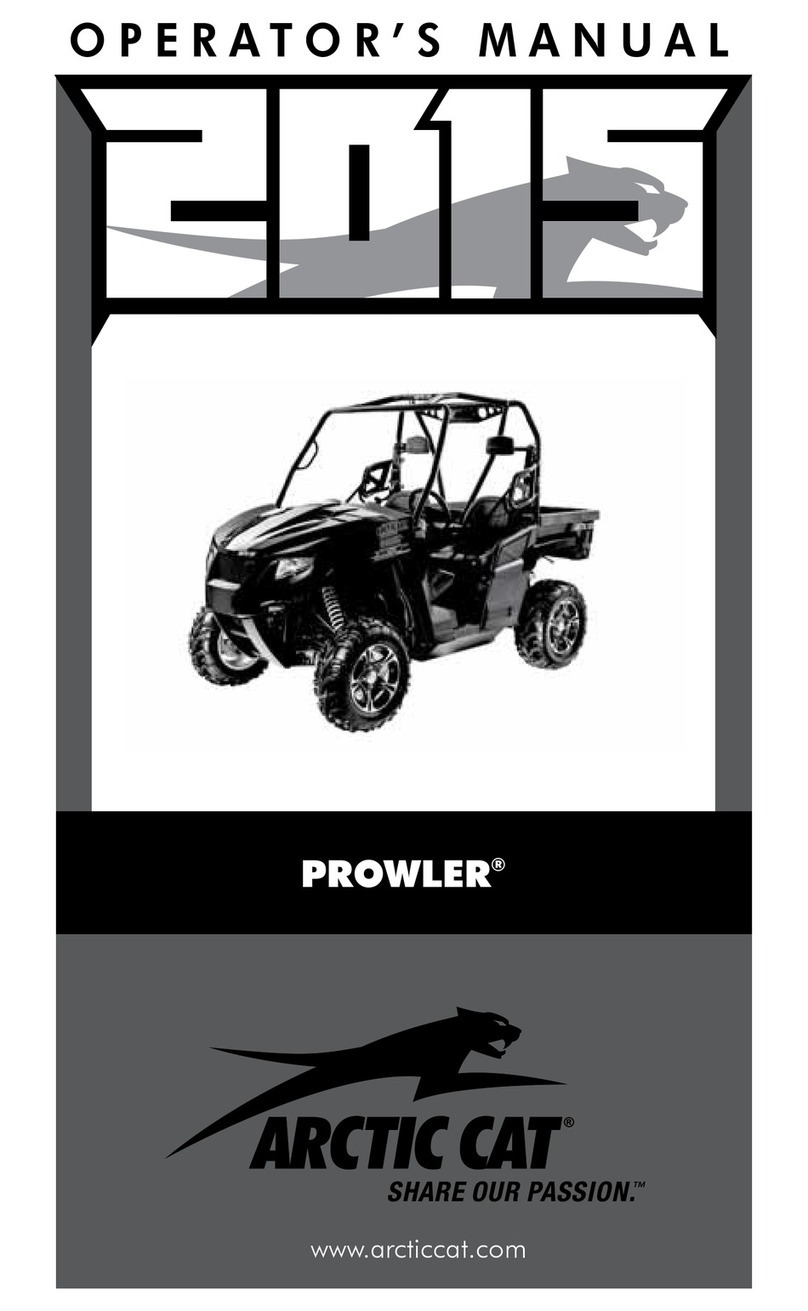Star EV Classic-Series User manual

Owner’s Manual and Service Guide
Star Classic, Star Sport, SS Limited, H-Series

2
Thanks for buying your Star EV. This manual contains information
you will need for proper operation, maintenance, and care of your
Star EV. A thorough understanding of these simple instructions will
help you to obtain maximum enjoyment from your new Star EV.
If you have any questions about the operation or maintenance of
your Star, please consult your Star EV dealer.
Read and understand this manual completely before operating your
Star EV.
This manual should be considered a permanent part of your Star EV
and should remain with the vehicle when lending or resold.

3
Models & Names
Vehicle Specifications
Overview
Important labels
Controls
Functions
Safety
Operation
Maintenance
Battery maintenance
Charger maintenance
Motor maintenance
Controller maintenance
Rear axle maintenance
Wheel maintenance
Brake adjustment
Lubrication
Troubleshooting
Periodic Maintenance Chart
Storage
Table of Contents
4
7
11
12
15
17
18
19
25
26
27
29
29
30
30
32
32
34

4
Important Information
Particularly important information is distinguished by the following notations:
WARNING: Failure to follow Warning instructions could result in severe injury to the
vehicle occupants, bystanders or persons inspecting or repairing the vehicle.
CAUTION: Failure to follow Caution instructions could cause damage to the vehicle.
Special Notice: Because the seat & backrest wrapping film may stick to the seat vi-
nyl and cause seat vinyl to fade or stain, remove the seat & backrest wrapping film
when you start to use the vehicle. Even if you plan to store the vehicle for a long
time, remove the seat & backrest wrapping film.
1: Models and Names
* Some models are shown with options like one-piece windshields and custom wheels.
Classic 36-2 Classic 36-2+2
Classic 48-2 Classic 48-2+2

5
Classic 48-4 Classic 48-4+2
Classic 48-6 Classic 48-6+2
Classic 36-2H, Classic 48-2H Classic 48-4H
Classic 48-6H Classic 48-2HCX (with various box attachment
options, not shown)

6
Classic 48-4HCX (with various box attachment
options, not shown) Sport 2+2
Sport 4+2 Sport 48-2H
Sport 48-4H Sport 48-2HCX

7
Star Classic Classic 36-2 and Classic 36-2+2
Passengers 2 or 4 (2 facing backward) Body Material Plastic
Battery System Six 6 V (36 V) batteries, Trojan
T-105 Front Suspension Leaf spring and shock
Motor Power 4 hp Advanced DC motor Steering System Rack and pinion
Controller Power 300 A Curtis programmable
controller Brake System Rear drum
Top Speed 18 mph Tire Size 205/50/10, 4-ply DOT tire
Load Capacity 36-2: 600 lbs / 36-2+2: 660 lbs Tire Pressure 30 psi
Dimensions
36-2: 94” x 47” x 72” (L x W x H)
36-2+2: 115” x 47” x 77” (L x
W x H)
Wheel Type 10” aluminum
Weight w/ Batteries 36-2: 1075 lbs / 36-2+2: 1245
lbs Roof
36-2: Molded plastic, beige
36-2+2: Fiberglass, col-
or-matched
Ground Clearance 5” Windshield Foldable, tinted
Turning Radius 10 Drive Train Direct rear drive with 10.25:1
ratio
Wheel Base 67” Voltage Reducer 20 A, 36 V to 12 V reducer
included
Top Climbing Grade 36-2: 25%
36-2+2: 20% Warranty
Four year limited warranty,
two year bumper-to-bumper
warranty (less wear items)
Star Classic Classic 48-2 and Classic 48-2+2
Passengers 2 or 4 (2 facing backward) Body Material Plastic
Battery System Eight 6 V (48 V) batteries,
Trojan T-105 Front Suspension Leaf spring and shock
Motor Power 5.5 hp Advanced DC motor Steering System Rack and pinion
Controller Power 400 A Curtis programmable
controller Brake System Rear drum
Top Speed 19.5 mph (20-25 mph if street
legal) Tire Size 205/50/10, 4-ply DOT tire
Load Capacity 48-2: 600 lbs / 48-2+2: 660 lbs Tire Pressure 30 psi
Dimensions
48-2: 94” x 47” x 72” (L x W x H)
48-2+2: 115” x 47” x 77” (L x
W x H)
Wheel Type 10” aluminum
Weight w/ Batteries 48-2: 1200 lbs / 48-2+2: 1370
lbs Roof
48-2: Molded plastic, beige
48-2+2: Fiberglass, col-
or-matched
Ground Clearance 5” Windshield Foldable, tinted
Turning Radius 10 Drive Train Direct rear drive with 10.25:1
ratio
Wheel Base 67” Voltage Reducer 20 A, 48 V to 12 V reducer
included
Top Climbing Grade 20% Warranty
Four year limited warranty,
two year bumper-to-bumper
warranty (less wear items)
2: Vehicle Specifications

8
Star Classic Classic 48-4 and Classic 48-4+2
Passengers 4 or 6 (2 facing backward) Body Material Plastic
Battery System Eight 6 V (48 V) batteries,
Trojan T-105 Front Suspension Leaf spring and shock
Motor Power 5.5 hp Advanced DC motor Rear Suspension Leaf spring and shock
Controller Power 400 A Curtis programmable
controller Steering System Rack and pinion
Top Speed 19.5 mph (20-25 mph if street
legal) Brake System Four-wheel hydraulic drum
brakes
Load Capacity 48-4: 660 lbs / 48-4+2: 1,000 lbs Tire Size
48-4: 205/50/10, 4-ply DOT tire
48-4+2: 20.5x8-10, 6-ply DOT
tire
Dimensions
48-4: 123” x 47” x 77”
48-4+2: 144” x 47” x 77”
(L x W x H)
Tire Pressure 48-4: 30 psi
48-4+2: 50 psi
Weight w/ Batteries 48-4: 1430 lbs
48-4+2: 1570 lbs Wheel Type 10” aluminum
Ground Clearance 5” Roof Fiberglass, color-matched
Turning Radius 12 Windshield Foldable, tinted
Wheel Base 96” Drive Train Direct rear drive with 10.25:1
ratio
Top Climbing Grade 20% Voltage Reducer 20 A, 48 V to 12 V reducer
included
Warranty Four year limited warranty, two year bumper-to-bumper warranty (less wear items)
Star Classic Classic 48-6 and Classic 48-6+2
Passengers 6 or 8 (2 facing backward) Body Material Plastic
Battery System Eight 6 V (48 V) batteries,
Trojan T-105 Front Suspension Leaf spring and shock
Motor Power 5.5 hp Advanced DC motor Rear Suspension Leaf spring and shock
Controller Power 400 A Curtis programmable
controller Steering System Rack and pinion
Top Speed 19.5 mph (20-25 mph if street
legal) Brake System Four-wheel hydraulic drum
brakes
Load Capacity 48-6: 990 lbs / 48-6+2: 1290 lbs Tire Size 20.5x8-10, 6-ply DOT tire
Dimensions
48-6: 153” x 47” x 77”
48-6+2: 173” x 47” x 77”
(L x W x H)
Tire Pressure 50 psi
Weight w/ Batteries 48-6: 1625 lbs / 48-6+2: 1800
lbs Wheel Type 10” aluminum
Ground Clearance 5” Roof Fiberglass, color-matched
Turning Radius 15 Windshield Foldable, tinted
Wheel Base 125” Drive Train Direct rear drive with 12.49:1
ratio
Top Climbing Grade 20% Voltage Reducer 20 A, 48 V to 12 V reducer
included
Warranty Four year limited warranty, two year bumper-to-bumper warranty (less wear items)

9
Sport Sport 2+2 and Sport 4+2
Passengers 4 of 6 (2 facing backwards on
both) Body Material Plastic
Battery System Eight 6 V (48 V) batteries,
Trojan T-105 Front Suspension Leaf spring and shock
Motor Power 5.5 hp Continuous Rear Suspension Leaf spring and shock
Controller Power 400 A Curtis controller Steering System Rack and pinion
Top Speed 17 mph (20-25 mph if street
legal) Brake System Rear drum
Load Capacity 2+2: 600 lbs / 4+2: 900 lbs Tire Size 23x10.5-12 DOT tire
Dimensions 2+2: 116” x 52” x 79” (L x W x H)
4+2: 138” x 52” x 85” (L x W x H) Tire Pressure 15 psi
Weight w/ Batteries 2+2: 1430 lbs / 4+2: 1650 lbs Wheel Type 12” steel
Ground Clearance 7" Roof Fiberglass, color-matched
Turning Radius 2+2: 10 / 4+2: 13 Windshield Foldable, tinted
Wheel Base 2+2: 68” / 4+2: 96” Drive Train Direct rear drive with 12:1 ratio
Top Climbing Grade 28% Voltage Reducer 20 A, 48 V to 12 V reducer
included
Warranty Four year limited warranty, two year bumper-to-bumper warranty (less wear items)
H-Series Classic 36-2H, 48-2H, 48-4H, and 48-6H
Passengers 2, 4, or 6 Top Climbing Grade 36- and 48-2H: 25% / 48-4H
and 6H: 20%
Battery System
36 V: Six 6 V batteries, Trojan
T-105 / 48 V: Eight 6 V batteries,
Trojan T-105
Brake System 36- and 48-2H: Rear drum
48-4H and 6H: Hydraulic drum
Motor Power
36 V: 4 hp Advanced DC motor
48 V: 5.5 hp Advanced DC
motor
Tire Size
36-2H, 48-2H, 4H: 205/50/10,
4-ply DOT
48-6H: 20.5 x 8x 10, 6-ply DOT
Controller Power 36 V: 300 A / 48 V: 400 A Tire Pressure 36-2H, 48-2H, 4H: 30 psi / 48-
6H: 50 psi
Top Speed
36 V: 18 mph
48 V: 19.5 mph (20-25 mph if
street legal)
Roof
36- and 48-2H: Molded plastic,
beige / 48-4H and 6H: Fiber-
glass, color-matched
Total Load Capacity 36- and 48-2H: 650 lbs / 48-4H:
960 lbs 48-6H: 990 lbs Drive Train
36- and 48-2H: Direct rear
drive, 10.25:1 / 48-4H and 6H:
Direct rear drive, 12.49:1
Cargo Capacity 300 lbs Front Suspension Leaf spring and shock
Body Material Plastic Rear Suspension Leaf spring and shock
Dimensions
36- and 48-2H: 115” x 47” x 72”
48-4H: 144” x 47” x 77”
48-6H: 153” x 47” x 77”
Weight w/ Batteries
36-2H: 1100 lbs / 48-2H: 1230
lbs / 48-4H: 1460 lbs / 48-6H:
1800 lbs
Box Dimensions 30” x 43” x 8.5” (L x W x H) Wheel Type 10” aluminum
Turning Radius 36- and 48-2H: 10 / 48-4H: 12
/ 48-6H: 15 Wheel Base 36- and 48-2H: 67” / 48-4H: 96”
/ 48-6H: 125”
Ground Clearance 5” Steering System Rack and pinion
Windshield Foldable, tinted Voltage Reducer 20 A, 48 V or 36 V to 12 V reduc-
er included
Warranty Four year limited warranty, two year bumper-to-bumper warranty (less wear items)

10
H-Series Classic 48-2HCX, Classic 48-4HCX
Passengers 2 or 4 Top Climbing Grade 20%
Battery System Eight 6 V batteries, Trojan
T-105 Brake System Hydraulic drum
Motor Power 5.5 hp Advanced DC motor Tire Size 20.5 x 8x 10, 6-ply DOT
Controller Power 400 A Tire Pressure 50 psi
Top Speed 19.5 mph (20-25 mph if street
legal) Roof
2HCX: Molded plastic, beige
4HCX: Fiberglass, color-
matched
Load Capacity 2HCX: 960 lbs / 4HCX: 1290 lbs Drive Train Direct rear drive, 12.49:1
Cargo Capacity 2HCX: 600 lbs / 4HCX: 800 lbs Front Suspension Leaf spring and shock
Body Material Plastic Rear Suspension Leaf spring and shock
Dimensions
2HCX: 132" x 47" x 73"
4HCX: 162" x 47" x 78"
(L x W x H)
Weight w/ Batteries 2HCX: 1500 lbs
4HCX: 1625 lbs
Box Dimensions 54" x 43" x 9.5" (L x W x H) Wheel Type 10” aluminum
Turning Radius 2HCX: 12 / 4HCX: 15 Wheel Base 2HCX: 96” / 4HCX: 125”
Ground Clearance 5” Steering System Rack and pinion
Windshield Foldable, tinted Voltage Reducer 20 A, 48 V to 12 V reducer
included
Warranty Four year limited warranty, two year bumper-to-bumper warranty (less wear items)
H-Series Sport 48-2H, Sport 48-4H, Sport 48-2HCX
Passengers 2 or 4 Top Climbing Grade
Battery System Eight 6 V batteries, Trojan
T-105 Brake System
Motor Power 5.5 hp Advanced DC motor Tire Size
Controller Power 400 A Tire Pressure
Top Speed 19.5 mph (20-25 mph if street
legal) Roof
Load Capacity 2H: 600 lbs / 4H: 930 lbs Drive Train
Cargo Capacity 2H: 300 lbs / 4H: 330 lbs Front Suspension
Body Material Plastic Rear Suspension
Dimensions Weight w/ Batteries
Box Dimensions Wheel Type
Turning Radius Wheel Base
Ground Clearance Steering System Rack and pinion
Windshield Foldable, tinted Voltage Reducer 20 A, 48 V to 12 V reducer
included
Warranty Four year limited warranty, two year bumper-to-bumper warranty (less wear items)

11
3: Overview
WARNING: Always confirm whether there are restrictions in the area where you in-
tend to use the vehicle. It is recommended that only people who possess a valid
motor vehicle driver’s license be allowed to operate golf cars.
Important Labels
Safety Label
Read carefully and understand the contents on the safety label. The label is at-
tached on the dash panel.
Vehicle Information
The name plate is either on the back of the seat pod or below the dashboard.

12
Chassis number of the vehicle
4: Controls
Note: There are two types of dashboards on STAR . The cup holder on the 2008 and
later (current) style dashboard is on top of the instrument panel and the cup holder
on the 2006 style dashboard is below the instrument panel.

13

14

15
Functions of Controls
Power Key: The power key is used to switch on the electrical system of the vehicle.
To engage the motor and start the vehicle, insert the key and turn it clockwise to
the ON position. At this time the 12V accessory system (headlights, turn signals,
taillights, brake lights and horn) will be engaged too. To switch the power o, turn
the key counterclockwise to the OFF position. CAUTION: When the key is in the ON
position, it cannot be pulled out. DO NOT try to remove the key when it is in the ON
position.
Forward/Reverse Switch: This is a three-position switch. The switch is used to shi
the golf car into forward or reverse. Press the switch up to move forward, down for
reverse, or in the middle for neutral. WARNING: This switch must be fully pressed
into the proper position or the electric system and motor will be damaged.
NOTE: The buzzer will beep when the lower part of this switch is pressed to warning
people around your vehicle.
Accelerator Pedal: The accelerator pedal is used to control speed while driving.
Press it down slowly to increase speed. The vehicle will speed up with the gradual
depression of the accelerator pedal, eventually reaching top speed when the pedal
is completely pressed down. The vehicle slows down with the liing of the pedal.
When the pedal is fully lied, the electric brake will engage and the vehicle will
come to a stop.
Service Brake Pedal: The service brake pedal is used for braking. The shape of
the pedal of the mechanical brake system and the hydraulic brake system is dier-

ent: refer to the figures below. NOTE: On the mechanical brake system, the service
brake pedal is combined with the parking brake pedal.
Parking Brake Pedal: The parking brake pedal is used in braking for parking. The
parking brake of the mechanical brake system is dierent from hydraulic brake sys-
tem. The parking brake of mechanical brake system is engaged by foot as shown
in above picture (refer to ‘Mechanical Brake’). The parking brake of the hydraulic
brake system is engaged by hand as shown in the figure below. The parking brake
should be engaged into parking position whenever the vehicle is le unattended.
How to engage and disengage the parking brake
Mechanical brake system
• To engage the parking brake, press down the service brake pedal com-
pletely, then press down the parking brake pedal until it locks.
• To disengage the parking brake, press down the service brake pedal until
the parking brake pedal is unlocked.
• WARNING: The foot park brake will automatically release when the accel-
erator pedal is stepped down. If the power key is in ON position, stepping
down the accelerator pedal may suddenly cause the vehicle to move.
Hydraulic brake system
• To engage the parking brake, pull up the hand brake lever to the end.
• To disengage the parking brake, pull the hand brake lever up completely
and press the button on the top of the brake lever. Return the brake lever
to the down position.
• WARNING: Always release the brake handle completely before driving the
vehicle. Do not press both the brake pedal and the accelerator together;
this will damage the motor.
Steering Wheel: The steering wheel is used to control the driving direction. Avoid
sudden and sharp turns.
Battery Power Meter: There are 10 calibration marks on the meter. The meter will
decline from the top to the bottom as the battery discharges. When the battery is
too low, the red indicator light will flash, reminding you to recharge the battery.
NOTE: Refer to your Battery Charger’s Owners Manual for how to recharge the bat-
teries.
16

17
Tow/Run Switch (available for Curtis 1266 and 1268 controller): Before oper-
ating the vehicle, make sure the TOW/RUN switch is on ‘RUN’ position. Make sure
the TOW/RUN switch is on the “TOW’ position if towing the vehicle. The TOW/RUN
switch is located under the seat on the passenger side either on the controller cover
or just under the rear body as shown on p. 13. WARNING: Whenever the TOW/RUN
switch is moved from the RUN position to the TOW position, move it back to the
RUN position, there is a delay of approximately 30 seconds before the vehicle will
run.
Turn Signal/Horn Switch: This switch is used to operate the turn signals and horn.
• Li up the handle lever to activate the horn.
• Push the handle lever up to activate the right turn signal.
• Pull the handle lever down to activate the le turn signal.
Headlight Switch: Pull out the button to switch on the headlight.
5: Safety
Star EVs are designed for simple operation; however, make sure you observe the
following safe operation instructions.
Before operating:
• Read the user manual thoroughly before operating the vehicle.
• Allow only authorized people to operate the vehicle, and only from the
driver’s side.
• Drive the vehicle only in areas where it is allowed by law or local regula-
tions.
• DO NOT allow more people than is permitted on the vehicle.
• DO NOT overload the vehicle, otherwise the motor may be damaged. The
vehicle may also lose control and/or the driver and passengers will be in
danger if overloaded.
• DO NOT operate the vehicle under the influence of alcohol or drugs.
• DO NOT climb any slope steeper than the vehicle’s climbing ability.
• DO NOT overtake other vehicles at crossroads, in blind spots or in any dan-
gerous areas.

During operation:
• Keep your entire body inside the vehicle, keep seated and hold on while
the vehicle is moving.
• Do not start the vehicle until all occupants are securely seated.
• Keep your hands on the steering wheel and your eyes on the path ahead.
• Always back up slowly, and watch carefully.
• Avoid starting or stopping suddenly.
• Avoid turning the steering wheel sharply at high speed.
• Always drive slowly up or down on a slope.
• Do not make any modification or addition which may aect the safety of
the vehicle.
6: Operation
Starting
1. With the Forward/Reverse switch on the Neutral position, turn the power key
to ON position.
• CAUTION: The car will not run if the F/R switch is set to Forward or Reverse
position before turning the key to the ON position.
• WARNING: Do not step down the accelerator pedal when turning the pow-
er key. Otherwise, the vehicle may suddenly start moving.
2. With the parking brake applied, press the Forward/Reverse switch and lock it
in the desired position.
• CAUTION: Do not shi from Forward to Reverse while the vehicle is mov-
ing.
3. Make sure that your path is clear. If the vehicle is equipped with the mechanic
braking system, press the lower section of the brake pedal to release the park
brake, and slowly press down the accelerator pedal. If the vehicle is equipped
with the hydraulic brake system, release the hand brake first before you press
the accelerator pedal.
• CAUTION: If the vehicle is equipped with mechanical brake system, press-
ing the accelerator pedal will release the parking brake if it is engaged.
Pressing the accelerator pedal is not the preferred method of releasing the
parking brake. Pressing the lower section of the brake pedal is the pre-
ferred method of releasing the parking brake to assure the longest service
life of brake components. If the key switch is ‘ON’ and parking brake is set,
pressing the accelerator inadvertently will release the parking brake and
18

19
will cause the vehicle to move which could cause severe injury or death.
• CAUTION: If the accelerator pedal is stepped down before the power key is
on, the vehicle will not run. In this case, you should release the accelerator
pedal first, and then turn the power key ON. Then, press down the acceler-
ator pedal again, and the vehicle will start to move.
Stopping
To stop the vehicle, gradually press down the brake pedal. When the vehicle
has come to a stop, apply the parking brake pedal and turn the power key to
OFF and press the F/R switch on Neutral position.
• CAUTION: Do not hold the vehicle on an incline with the accelerator: use
the brake.
7: Maintenance
Users should perform regular maintenance to ensure the vehicle is in good condi-
tion.
Battery Maintenance
NOTE: STAR EVs are equipped with deep-cycle flooded lead-acid batteries. If your
vehicle is equipped with another type of battery, follow the maintenance instruc-
tions provided by the battery manufacturer. Below maintenance instruction is es-
pecially for deep-cycle flooded lead-acid battery.
WARNING! Battery electrolyte is poisonous and dangerous, and may cause severe
burns or injury. Always wear protective clothing, gloves, and goggles when han-
dling batteries, electrolyte, and charging your battery. KEEP OUT OF REACH OF
CHILDREN.
Cleaning
1. The exterior of the battery, the connection wires and bolts should always be
kept clean and dry. When cleaning, make sure all vent caps are tightly in place.
Clean the battery top with a cloth or brush and solution of baking soda and wa-
ter. When cleaning, do not allow any cleaning solution or other foreign matter
to get inside of the battery. This should be done every week.

20
2. Clean battery terminals and the inside of cable clamps using a post and clamp
cleaner. Clean terminals will have a bright metallic shine. This should be done
as needed.
3. Reconnect the clamps to the terminals and thinly coat them with petroleum
jelly (Vaseline) to prevent corrosion.
• WARNING! Before you disconnect any battery cable from any terminal on
the battery, always remove the power by disconnecting the main battery
cable from the controller.
Checking the terminals and nuts: The connection of the batteries should be kept
in good condition. Check the battery cable terminals and nuts weekly in order to
prevent sparking or damage to terminals. A damaged battery cable should be re-
placed immediately.
Battery compartment: Do not place any objects on the battery and do not con-
nect the positive pole to the negative pole. This may cause a short circuit or danger-
ous sparking. This can cause damage to the battery or injury to the user.
Recharging
1. Regardless of how long you have used the vehicle, the battery should be re-
charged fully on the same day. Any delay on the re-charging will reduce the life
of the battery. Note: The lead-acid battery does not develop a memory, so it
need not be fully discharged before recharging.
2. If the vehicle is going to be kept unused for a long time, the battery should be
fully recharged first. Aer that, the battery should be fully recharged every 2
weeks.
3. When driving, the driver should be aware of the drop level of the battery power
from the battery power meter. The driver should estimate the distance needed
to be taken, and recharge the battery at a proper time to ensure that the vehi-
cle can get back to the charging location in time for recharging.
• WARNING! Make sure the battery is recharged before the battery power
meter shows 20% is le. An over-discharged battery will have a very short
service life.
• WARNING! During recharging, the vehicle should be parked in a well-ven-
tilated area with filling caps tightly secured. Keep far away from any flame
and sparks to avoid any explosion or fire that could cause physical injury
or damage to property.
This manual suits for next models
3
Table of contents
Other Star EV Golf Car manuals
